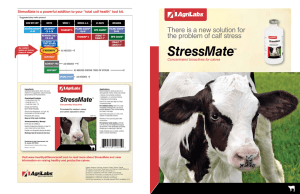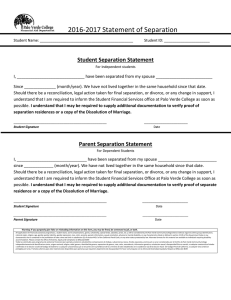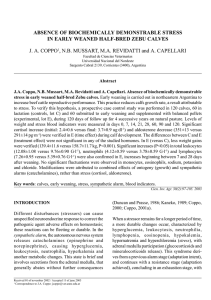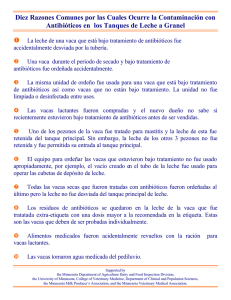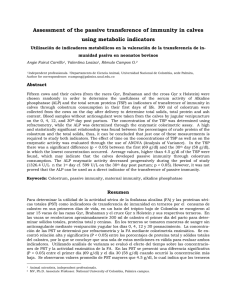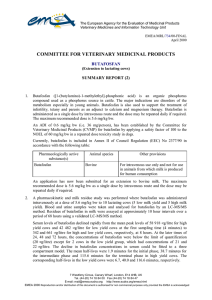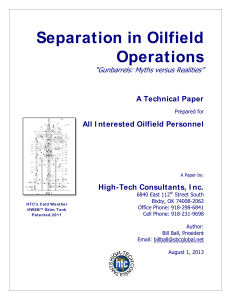English
Anuncio
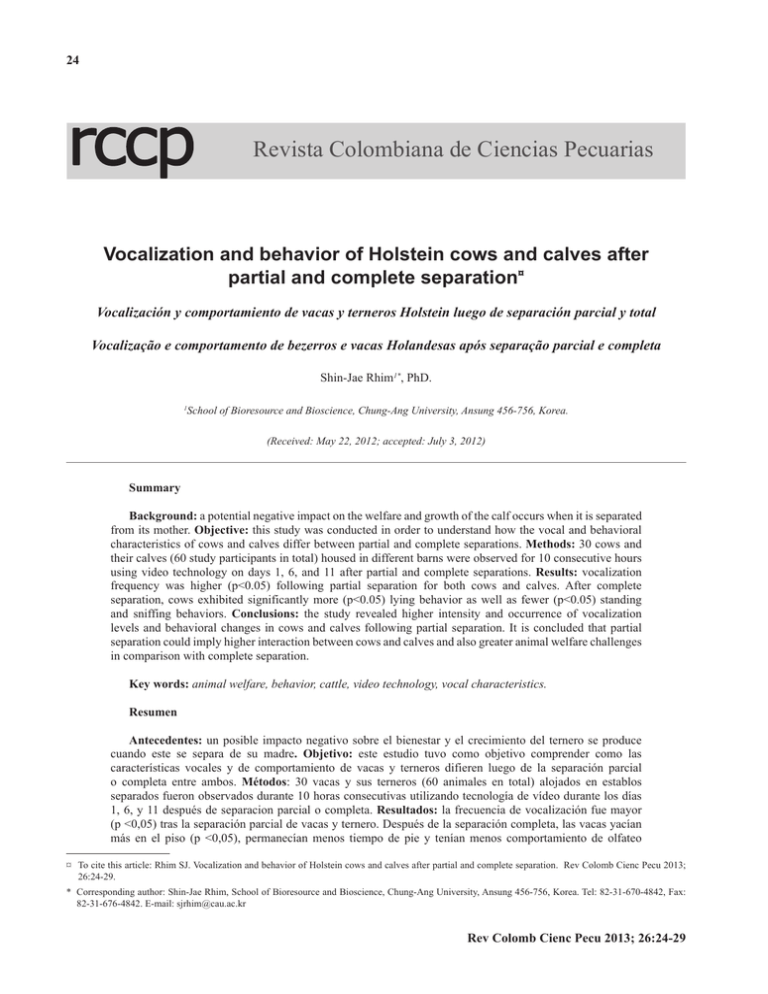
24 Rhim SJ Holstein cow and calf behavior following separation Revista Colombiana de Ciencias Pecuarias Vocalization and behavior of Holstein cows and calves after partial and complete separation¤ Vocalización y comportamiento de vacas y terneros Holstein luego de separación parcial y total Vocalização e comportamento de bezerros e vacas Holandesas após separação parcial e completa Shin-Jae Rhim1*, PhD. School of Bioresource and Bioscience, Chung-Ang University, Ansung 456-756, Korea 1 (Received: May 22, 2012; accepted: July 3, 2012) Summary Background: a potential negative impact on the welfare and growth of the calf occurs when it is separated from its mother. Objective: this study was conducted in order to understand how the vocal and behavioral characteristics of cows and calves differ between partial and complete separations. Methods: 30 cows and their calves (60 study participants in total) housed in different barns were observed for 10 consecutive hours using video technology on days 1, 6, and 11 after partial and complete separations. Results: vocalization frequency was higher (p<0.05) following partial separation for both cows and calves. After complete separation, cows exhibited significantly more (p<0.05) lying behavior as well as fewer (p<0.05) standing and sniffing behaviors. Conclusions: the study revealed higher intensity and occurrence of vocalization levels and behavioral changes in cows and calves following partial separation. It is concluded that partial separation could imply higher interaction between cows and calves and also greater animal welfare challenges in comparison with complete separation. Key words: animal welfare, behavior, cattle, video technology, vocal characteristics Resumen Antecedentes: un posible impacto negativo sobre el bienestar y el crecimiento del ternero se produce cuando este se separa de su madre. Objetivo: este estudio tuvo como objetivo comprender como las características vocales y de comportamiento de vacas y terneros difieren luego de la separación parcial o completa entre ambos. Métodos: 30 vacas y sus terneros (60 animales en total) alojados en establos separados fueron observados durante 10 horas consecutivas utilizando tecnología de vídeo durante los días 1, 6, y 11 después de separacion parcial o completa. Resultados: la frecuencia de vocalización fue mayor (p <0,05) tras la separación parcial de vacas y ternero. Después de la separación completa, las vacas yacían más en el piso (p <0,05), permanecían menos tiempo de pie y tenían menos comportamiento de olfateo ¤ To cite this article: Rhim SJ. Vocalization and behavior of Holstein cows and calves after partial and complete separation. Rev Colomb Cienc Pecu 2013; 26:24-29. * Corresponding author: Shin-Jae Rhim, School of Bioresource and Bioscience, Chung-Ang University, Ansung 456-756, Korea. Tel: 82-31-670-4842, Fax: 82-31-676-4842. E-mail: sjrhim@cau.ac.kr Rev Colomb Cienc Pecu 2013 26:24 29 Rhim SJ Holstein cow and calf behavior following separation 25 (p <0,05). Conclusiones: el estudio reveló una mayor intensidad y frecuencia de vocalizaciones y cambios de comportamiento en las vacas y los terneros tras la separación parcial. Se concluye que la separación parcial podría implicar una mayor interacción entre las vacas y los terneros y también mayores desafíos de bienestar animal en comparación con la separación completa. Palabras clave: bienestar animal, características vocales, comportamiento, ganado, tecnología de video Resumo Antecedentes: um possível impacto negativo no bem-estar e crescimento ocorre quando o bezerro é separado de sua mãe. Objetivo: descrever as características comportamentais e emissões vocais de bezerros e vacas Holandesas após separação parcial e completa. Métodos: 30 vacas e seus bezerros (para um total de 60 amostras no estudo) localizados em diferentes lugares foram observados consecutivamente usando a tecnologia do vídeo por 10 h nos dias 1, 6 e 11 em separações completas e parciais. Resultados: a frequência de emissões vocais foi maior tanto nas vacas quanto nos bezerros (p<0,05) após uma separação parcial. Após uma separação completa, as vacas exibiram com uma frequência significativamente maior o comportamento de estar deitadas (p<0,05), tanto quanto significativamente menor (p<0,05) o comportamento de estar paradas e de cheirar. Conclusões: a pesquisa revelou maiores níveis de vocalização e comportamento nas vacas e bezerros após a separação parcial. Conclui-se com estes resultados que a separação parcial permite uma maior interação entre a vaca e o ternero, fato que implica um maior desafio em relação ao bem-estar animal comparado com a separação completa. Palavras chave: bem-estar animal, comportamento, gado de leite, tecnologia de vídeo, vocalização Introduction In intensive dairy farming, it is common to remove the calf from the cow immediately or shortly after parturition and to rear the calf on whole milk or a milk substitute using buckets or nipples (Khan et al., 2007; Budzynska and Weary, 2008; Fröberg et al., 2008). The milk-feeding period is very critical (Svensson et al., 2003), as calves at this age are at greatest risk for diarrhea and respiratory diseases (Lundborg et al., 2005). Handling the calf immediately following birth is necessary for routine management procedures (Turner and Lawrence, 2007; Fröberg and Lidfors, 2009). Housing the calves in individual booths is thought to help control disease, abnormal sucking behavior, and feed intake (Nielsen, 2009; Duve and Jensen, 2011). There are indications that early interactions between cow and calf resulting from the calf’s colostrum intake extend beyond the immune system bene ts (Krohn et al., 1999). Cow and calf separation can cause stress, particularly if the separation occurs after a substantial period of time together. Following initial separation, the cow makes attempts to reunite with the calf through increased locomotion and vocalization and can even Rev Colomb Cienc Pecu 2013 26:24 29 resort to breaking separation fences (Phillips, 2002). Social isolation is stressful for calves (Raussi et al., 2003) and may inhibit the acquisition of essential social skills needed to cope in a group environment, which all dairy cattle are subjected to later in life (Veissier et al., 1994). Growing up without contact with the mother has severe consequences for young animals (Roth et al., 2009). A potentially negative impact on calf welfare occurs when it is separated from its mother. Early separation can result in adverse effects such as the thwarting of maternal behavior, which can eventually lead to isolation of the neonate (Flower and Weary, 2003). Responses to separation within the rst 10 minutes, including increased heart rate and vocalization, are quite mild (Hopster et al., 1995). When cows and their calves are separated, they spend a long time pacing the eld boundaries in an attempt to reunite as well as standing and watching each other (Price et al., 2001). Moreover, the management system can in uence cow and calf behavior. Calves raised in isolation can excessively lick themselves as well as foreign objects. (Stephens, 1982; Wood-Gush et al., 1984). No study in South Korea has been conducted on the behavioral research of Holstein cows and 26 Rhim SJ Holstein cow and calf behavior following separation calves after separations. This study focused on investigating differences in the vocal and behavioral stress of Holstein cows and calves as a result of different separation methods. Methods This study was carried out at the experimental research station of Chung-Ang University, located in Ansung, Gyeonggi Province, Korea. A total of 30 cows and 30 calves were observed. All of the cows gave birth to their calves in separate calving pens (3.0 x 3.0 m). Calves were separated from their mothers on the day of birth using either partial or complete separation methods. For partial separation, the calf was housed in a barn (3.0 x 3.0 m) adjacent to the cow barn (6.0 x 6.0 m), with no visible contact with the mother. The barns were separated by a solid wood wall, which visually isolated the cow and calf. However, they could recognize each other via auditory and olfactory senses through the barrier. During complete separation the calf was isolated in a separate barn (3.0 x 3.0 m) located a far distance from the other. Calves were bottle fed whole milk while cows were fed a total mixed ration (TMR) twice a day along with full access to water. Cows were machine milked by the staff twice daily at 06:00 and 16:00. All cows and calves were kept in an enclosed barn on deep litter without access to a barnyard or pasture and their health was monitored throughout the study, at least two times weekly. Fifteen replicates of each treatment were evaluated during 2007 and 2008. Two wideangle video cameras were installed at the corner of the ceiling. Cow and calf behavior was videorecorded continuously for 10 h per day over 3 non-consecutive days. Behaviors were analyzed based on images and vocalizations digitally recorded from 08:00 to 18:00 h on days 1, 6, and 11 (day 0 = day of birth). Video was analyzed using a jog-shuttle function. Instantaneous scan sampling was carried out at 2 min intervals. In order to eliminate subjective bias and potential discrepancies among individuals, all video recordings were viewed by a trained observer with no knowledge of the treatment (Li and Wang, 2011). Vocalizations were determined based on direct video observation. The following behaviors were recorded: standing, lying, eating, ruminating, licking, snif ng, among others (Table 1). The frequency and duration (in minutes) of these behaviors was recorded from video recordings of days 1, 6, and 11 following separation. Table 1. Observed behaviors and their respective definitions (adapted from Loberg et al., 2008; Fröberg and Lidfors, 2009). All behaviors were recorded in the scan sampling. Behavior Description Vocalizing Making an audible sound through the mouth Standing Standing at certain position without movement Lying Lying down in any resting position Eating Taking TMR in to the mouth followed by chewing and swallowing Ruminating Chewing after regurgitating Licking Licking objects or themselves Snif ng Appearing to inhale air through the nose Other All other behaviors not listed above All data were analyzed using the Glimmix procedure of the SAS software (SAS Inst. Cary, NY, USA) with the pen serving as the experimental unit. The residual data sets were tested for normal distribution using the Univariate procedure of SAS. The data were log-transformed to follow normal distribution (Zar, 1999) and analyzed by ANOVA. Tukey’s post hoc tests were used to determine pair-wise differences between treatments; signi cance was declared at p<0.05. Results Separation exhibited a signi cant impact on the frequency of vocalizations for calves under partial (ANOVA, F2,28 = 8.59, p<0.05) and complete (F2,28 = 17.26, p<0.001) separation periods. During partial separation, calf vocalization frequency was greater on days 1 and 6 (Tukey’s test, p<0.05). Also, the calf vocalization frequency was higher on day 1 and lower on day 11 (p<0.01). There were no differences in cow vocalization frequency undergoing partial separation (F2,28 = -2.14, p = 0.27). However, cow vocalization frequency differed signi cantly Rev Colomb Cienc Pecu 2013 26:24 29 27 Rhim SJ Holstein cow and calf behavior following separation Frequency (%) on days 1, 6, and 11 during complete separation (F2,28 = 19.35, p<0.001). Vocalization frequency was higher on day 1 than days 6 and 11 (p<0.01). There were no differences in vocalization frequency for cows and calves on day 1 under both partial and complete separations. However, vocalization frequency was signi cantly different under partial and complete separation conditions for cows and calves (Figure 1). Calf in partial separation Calf in complete separation Cow in partial separation Cow in complete separation Figure 1. Square root transformed least square means (± SE) for the proportion of time spent vocalizing at day 1, day 6, and day 11 following partial and complete separations. Different letters indicate significant differences between the mean values on a given day (p<0.05). Total duration of standing for cows was signi cantly different in partial (F2,28 = 6.91, p<0.05) versus complete (F2,28 = 9.47, p<0.05) separations at days 1, 6, and 11 following separation. The duration of standing time was long at day 1 and short at day 11 in both cases (p<0.05). Time spent lying was signi cantly different among days 1, 6, and 11 in partial (F2,28 = 8.16, p<0.05) and complete (F2,28 = 12.38, p<0.05) separations. The duration of lying was higher in day 11 and lower in day 1 for both separations (p<0.05). The frequency of snif ng was not signi cantly different for partial (F2,28 = -10.23, p= 0.58) and complete (F2,28 = -15.39, p= 0.76) separations on days 1, 6, and 11 (Table 2). For calves, the total duration of standing was different for partial (F2,28 = 5.23, p<0.05) and complete (F2,28 = 6.42, p<0.05) separation between days 1, 6, and day 11 following separation. The duration of standing was higher on day 1 and lower on day 11 for both partial (p<0.05) and complete (p<0.05) separations. However, the duration of lying increased as time passed. During partial separation, the frequency of licking (F2,28 = -4.15, p= 0.45) and snif ng (F2,28 = -7.52, p = 0.67) was not signi cantly different according to the day. However, licking and snif ng frequency was higher on day 1 (p<0.05) and lower on day 11 (p<0.05) (Table 3). Table 2. Mean (±S.E.) behavior of cows on days 1, 6, and 11 following partial and complete separation. Behaviors Total duration of standing (min/h) Transformed data Total duration of lying (min/h) Transformed data Frequency of snif ng (No./h) Transformed data Day 1 Partial Complete Day 6 Partial Complete Day 11 Partial Complete 24.3±3.6 1.8b 5.6±1.4 1.1d 45.3±6.8 2.1a 25.6±5.7 1.8b 10.5±2.3 1.4c 47.2±4.5 2.1a 21.2±2.1 1.7b 11.3±1.9 1.4c 42.6±5.3 2.0a 22.7±2.9 1.8b 15.2±2.9 1.5c 21.7±3.5 1.7b 17.2±3.4 1.5c 18.2±4.3 1.6b 19.3±2.4 1.7b 13.1±2.4 1.4c 19.3±3.1 1.7b 20.1±3.1 1.7b Different letters indicate significant differences between mean values on a given day (p<0.05). Table 3. Mean (±S.E.) behavior of calves at day 1, 6, and 11 following partial and complete separations. Behaviors Total duration of standing (min/h) Transformed data Total duration of lying (min/h) Transformed data Frequency of licking (No./h) Transformed data Frequency of snif ng (No./h) Transformed data Day 1 Partial Complete Day 6 Partial Complete Day 11 Partial Complete 32.1±6.3 2.0a 3.4±1.1 0.9d 47.2±5.9 2.2a 31.2±2.6 2.2a 30.8±3.4 2.0a 6.2±2.7 1.3c 39.3±3.9 2.1a 29.8±3.1 2.2a 25.2±3.5 1.8b 6.0±1.3 1.3c 30.2±6.1 2.2a 34.2±3.9 2.2a 30.7±4.2 2.0a 5.7±1.4 1.3c 49.3±3.6 2.2a 34.6±2.9 2.2a Different letters indicate significant differences between mean values on a given day (p<0.05). Rev Colomb Cienc Pecu 2013 26:24 29 21.3±2.9 1.8b 8.5±2.1 1.4c 26.9±5.1 1.8b 20.3±2.1 1.8b 15.4±1.7 1.6b 15.2±2.6 1.6b 15.1±3.3 1.6b 18.3±2.7 1.7b 28 Rhim SJ Holstein cow and calf behavior following separation Discussion Cows and calves in this study demonstrated a strong vocal response following separation, with many demonstrating peak response on the rst day following separation in both partial and complete separations. During complete separation, vocalization decreased as time passed, as compared with partial separation. Future studies on this topic should continue to monitor vocal responses until a clear trend towards baseline levels is shown. Following separation, all cows demonstrated vocalizations, indicating that cows respond maternally in looking for their calves (Hopster et al., 1995; Loberg et al., 2008). Cattle are known to respond vocally, physically, and psychologically to stressful situations (Watts and Stookey, 2000). Previous studies suggest that calves are often highly vocal following separation after weaning (Thomas et al., 2001; Jasper et al., 2008). Separation can be highly stressful for the calves. Watts (2001) observed pairs naturally separated under extensive pasture conditions, reporting that both cows and calves demonstrated an increase in their rate of vocalization and spent more time walking, which culminated in reunion and nursing. Domesticated animals in intensive husbandry settings often demonstrate behaviors that occur outside of their normal functional context. For example, calves reared separately from their mothers and hand-fed milk will occasionally suck on objects in the pen or at other calves (Mason and Rushen, 2006; Rushen et al., 2008). During this study, the total duration of standing during partial separation was greater for the cows in days 6 and 11 than in complete separation. Most of this behavior involved standing with the head toward the wooden wall. This behavior suggests the cow’s willingness to reunite with the calf. Calves tended to stand with their head toward the wooden wall during partial separation. Partial separation may facilitate the attachment between dam and calf. Vocal and olfactory senses may have interfered with attachment. Time lying down increased for cows and calves in the days following both types of separation, suggesting a gradual adaptation to their new environments. During complete separation, the vocalization frequencies of cows and calves signi cantly declined at days 6 and 11, suggesting adaptation following separation between dams and their calves. According to the results observed in this study, partial separation is good for calf welfare. Vocalization and behaviors such as lying, standing, and snif ng may be alternative responses to separation. There is evidence of consistent yet unique differences among calf response to diverse challenges (van Reenen et al., 2004). No physiological measures were taken in this study, but other physiological research has supported the hypothesis that separation is a stressful experience for both mother and young. Lefcourt and Elsasser (1995) reported increases in peripheral catecholamine concentrations in beef calves as well as increases in epinephrine concentrations in dams in response to separation. Under commercial conditions, the dairy cow and calf should be separated in order for the cow to be milked. One current argument against early cow-calf contact is that the immediate distress of separation remains high (Flower and Weary, 2001). Because separation is linked to distress, it has been suggested that the cow and calf should have the opportunity to stay together for some time. The question of how to balance the positive effects of early cow-calf contact against the negative effects of distress following separation remains to be answered. Further research is needed to determine the underlying biological characteristics of the cows and calves that are behaviorally observed during long term studies following separation. References Budzynska M, Weary DM. Weaning distress in dairy calves: effects of alternative weaning procedures. Appl Anim Behav Sci 2008; 112:33-39. Duve LR, Jensen MB. The level of social contact affects social behaviour in preweaned dairy calves. Appl Anim Behav Sci 2011; 135:34-43. Flower FC, Weary DM. Effects of early separation on the dairy cow and calf: 2. Separation at 1 day and 2 weeks after birth. Appl Anim Behav Sci 2001; 70:275-284. Rev Colomb Cienc Pecu 2013 26:24 29 Rhim SJ Holstein cow and calf behavior following separation Flower FC, Weary DM. The effects of early separation on the dairy cow and calf. Anim Welfare 2003; 12:339-348. Fröberg S, Gratte E, Svennersten-Sjaunja K, Olsson I, Berg C, Orihuela A, Galin CS, García B, Lidfors L. Effect of suckling (‘restricted suckling’) on dairy cows’ udder health and milk letdown and their calves’ weight gain, feed intake and behaviour. Appl Anim Behav Sci 2008; 113:1-14. Fröberg S, Lidfors L. Behaviour of dairy calves suckling the dam in a barn with automatic milking or being fed milk substitute from an automatic feeder in a group pen. Appl Anim Behav Sci 2009; 117:150-158. Hopster H, O’Connell JM, Blokhuis HJ. Acute effects of cowscalf separation on heart-rate, plasma-cortisol and behavior in multiparous dairy-cows. Appl Anim Behav Sci 1995; 44:1-8. Jasper J, Budzynska M, Weary DM. Weaning distress in dairy calves: acute behavioural responses by limit-fed calves. Appl Anim Behav Sci 2008; 110:136-143. Khan MA, Lee HJ, Lee WS, Kim HS, Kim SB, Ki KS, Ha JK, Lee HG, Choi YJ. Pre- and postweaning performance of Holstein female calves fed milk through step-down and conventional methods. J Dairy Sci 2007; 90:876-885. Krohn CC, Foldager J, Mogensen L. Long-term effect of colostrum feeding methods on behaviour in female dairy calves. Acta Agric Scand (Section A: Anim Sci) 1999; 49:57-64. Lefcourt AM, Elsasser TH. Adrenal responses of Angus x Hereford cattle to the stress of weaning. J Anim Sci 1995; 73:2669-2676. Li Y, Wang L. Effects of previous housing system on agonistic behaviors of growing pigs at mixing. Appl Anim Behav Sci 2011; 132:20-26. Loberg J, Hernandez CE, Thierfelder T, Jensen MB, Berg C, Lidfors L. Weaning and separation in two steps – a way to decrease stress in dairy calves suckled by foster cows. Appl Anim Behav Sci 2008; 111:222-234. Lundborg GK, Svensson EC, Oltenacu PA. Herd-level risk factors for infectious diseases in Swedish dairy calves age 0-90 days. Prev Vet Med 2005; 68:123-143. Mason G, Rushen J. Stereotypic animal behaviour: fundamentals and implications for animal welfare. 2nd ed. Oxford: CABI; 2006. 241 p. Nielsen SS. Use of diagnostics for risk-based control of paratuberculosis in dairy herds. In Pract 2009; 31:150-154. Phillips C. Cattle behaviour & welfare. Oxford: Blackwell Publishing; 2002. 264 p. Price EO, Harris JE, Borgward RE, Sween ML. Fenceline contact reduces the negative effects on weaning on the behavior Rev Colomb Cienc Pecu 2013 26:24 29 29 and growth of beef calves. In: Garner J, Mench J, Heekin S, editors. The 35th International Congress of ISAE. Davis: International Society for Applied Ethology; 2001. 41 p. Raussi S, Lesink BJ, Boissy A, Pyykkönen M, Veissier L. The effect of contact with conspeci cs and humans on calves’ behaviour and stress responses. Anim Welfare 2003; 12:191203. Roth BA, Barth K, Gygax L, Hillmann E. In uence of arti cial vs. mother-bonded rearing on sucking behaviour, health and weight gain in calves. Appl Anim Behav Sci 2009; 119:143-150. Rushen J, de Passillé AM. The motivation of non-nutritive sucking in calves Bos taurus. Anim Behav 2008; 49:1503-1510. Stephens DB. A review of some behavioural and physiological studied which are relevant to the welfare of young calves. In: Signoret JP, editors. Welfare and husbandry of calves. Hague: Martinus Nijhoff Publishing; 1982. p. 47-69. Svensson C, Lundborg K, Emanuelson U, Olsson S. Morbidity in Swedish dairy calves from birth to 90 days of age and individual calf-level risk factors for infectious diseases. Prev Vet Med 2003; 58:179-197. Thomas TJ, Weary DM, Appleby MC. Newborn and 5-weekold calves vocalize in response to milk deprivation. Appl Anim Behav Sci 2001; 74:165-173. Turner SP, Lawrence AB. Relationship between maternal defense aggression, fear of handling and other maternal care traits in beef cows. Livest Sci 2007; 106:182-188. Van Reenen CG, Engel B, Ruis-Heutinck LF, van der Werf JTN, Buist WG, Jones RB, Blokhuis HJ. Behavioural reactivity of heifer calves in potentially alarming test situations: a multivariate and correlational analysis. Appl Anim Behav Sci 2004; 85:11-30. Veissier K, Gesmier V, Neindre P, Gautier JY, Bertand G. The effects of rearing in individual crates on subsequent social behaviour of veal calves. Appl Anim Behav Sci 1994; 41:199210. Watts JM. Vocal behaviour and welfare in cattle. Ph.D. dissertation, University of Saskatchewan, Saskatoon; 2001. 217 p. Watts JM, Stookey JM. Vocal behaviour in cattle: the animal’s commentary on its biological processes and welfare. Appl Anim Behav Sci 2000; 67:15-33. Wood-Gush DGM, Hunt K, Carson K, Dennison SGC. The early behaviour of suckler calves in the eld. Biol Behav 1984; 9:295-306. Zar JH. Biostatistical analysis. 4th ed. Upper Saddler River: Prentice-Hall Inc.; 1999. 663 p.
